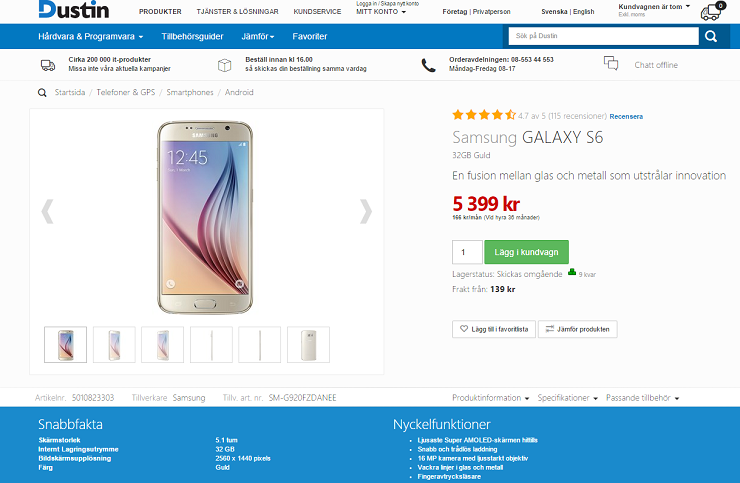
The Informed Customer
Whether we want to admit it or not, we have been information dependant – the constant information hunt has become a behaviour. It is natural to google a question on the smart phone, tablet or computer, and the page who gets to answer the question is the winner. For those of you who sell online, it is not only important to be in the top search result, but really display the right image of the product to your customers. The information you present sends a message to the customer that you care or not. Lacking information about the product direct from a business system or a lot of enriched information suited for e-commerce? It can be the factor that is decisive for an order.
You probably read this article to gather information to improve your e-commerce. In similar ways, your customers gather information to make their purchases as good as possible. Today we have created a general behaviour where we look for information whether it is a product, news, a recipe, or a YouTube-video. The informed customer gather information; search, compare, and question. An order can very well go to a supplier with a slightly higher price, but who meets the information need, and therefore creates trust. Since we humans rather buys from the ones we trust. That also applies whether if it is a web shop that we order from.
Product Information
For an e-commerce site, the most important information messenger is the product. Traditionally, B2B has a legacy of sales from a catalogue, or from data in a business system, where both sources have their limitations in information content. The customer expects more and more today more information and better quality in the information in e-commerce than the business system or catalogue can meet.
The product information is the base for both the organic search by an external search engine as Google, Bing, or Yahoo as well as the internal search that should make it easier for the customer to find the product at the site once the customer has found the site. To be visible in the search, is your way of showing that you exist.

For several B2B sellers, the catalogue is the foundation that the sales rely on. If you sell through a catalogue, take a moment and reverse the ideas of the catalogue. Why not see the web as your base for selling information? What are the pros of seeing the web as the foundation for information, instead of the catalogue?
|
Web |
Catalogue |
|
Reflects the product range as it looks rights now. New information and new images can quickly be added. A constantly up-to-date product catalogue with the latest products. When a product is available for sales, it is available for the customers. |
Stops being up-to-date as soon as it goes to print if the product range changes. The catalogue doesn’t reflect the product range right now, only as it looked when the catalogue was printed. New products are not available for the customer. |
|
The information is near the source of date, whether the origin is in a business system, or on the web or in a PIM. Data is updated frequently through integrations. |
The information is far away from the source of data. Once the catalogue is created, there is no connection to the actual source. |
|
You can adapt the display to what you want to sell. The changes are made continuously after the customers’ behaviour on the site. |
All products are given the same value. The catalogue is often a register of the product range, rather than a material to drive sales. |
|
It is hard on the web to get a good overlook of the product range. Searches are an alternative. |
It is a lot faster to browse through an entire catalogue and form an opinion of the range. The customer can quickly catch on to the structure. |
|
If you are not by the computer, this is an extra moment to start up the computer and finding the right page. You can on the other side find the products from any unit independent on where you are. |
The catalogue is easy to find if you are at your work place. It can seem easier. If you are not where the physical catalogue is, you won’t be able to access the products. |
|
Direct relation to related products through links. The customer can easily find the right place. |
You could show relations by correlations between pages. |
|
There is basically unlimited possibilities to showing the information online. You can use tabs, menus, accordions (elements that can be maximized and minimized), and links. It is easy to hide text fields with no values, It is possible to add other specifications in form of attached documents. |
Everything is displayed right away, but is strict to templates and the space for information is limited. |
|
The possibility for several images, zoom, 360 degrees rotations, and videos. |
The catalogue format is limited to a few and small images. |
|
Consists of actual product information, but no physical documents. |
The catalogue is a physical document that works offline. |
We have previously written about omnichannel, we can see the web and the catalogue as different sales channels, where both are equally important with different strengths. That the web is the sales channels with up-to-date information is for me the crucial difference. The web can generate catalogues on demand, either periodically or adjusted after specific need, for example to a customer or project containing all or part of the product range.
Think Mobile Units
The mobile phone has become the Swiss knife and the life line today. Something everyone bring, always, a first-hand choice to seek information.
When you talk product information, you mainly think of it as a window display that a desktop computer can offer. Equally important is thinking about the mobile experience. If the desktop site offers an entire window display for the products, the mobile offers a minimal basement window to show the products. The customers want a lot of information, in a mobile, only a small part of the information will fit, and there is a contradiction. The customer is aware of the dilemma, and doesn’t expect all information instantly in their mobile phone, but is happy with the most important things first. But it should be possible to find all information if needed.
Think about how your customers use their mobile phone, and what information that is most important for them to see straight away in the mobile. For responsive sites, sites that adjust the content by device, you usually talk about mobile first. You go through the design from the unit that can show the least information and prioritize what is most important. To a tablet or laptop, you just then add more information that increases the experience, but is not absolutely necessary.
- In what context does your customers use the mobile phone?
- Which information must be visible then?
- Which aids should be visible straight away?
Through a good search, the customer should be able to find basically everything at the site; products, content, and self service. Adding the internal search as a constantly present element is recommended. This is something that is usually called sticky, an element that sticks for example at the top of the screen when you scroll. At the same time you lock valuable screen-real-estate (Jakob Nielsen’s fitting term for the valuable screen surface), so you can only have the most important things sticky. Add a hamburger menu as a complement (an icon with three parallel horizontal lines), and the shopping basket, and you will have a nice and compact starting point to be able to navigate on the site and finding all information, and completing orders no matter which page you are on.
Of course, we at 3bits as a supplier of e-commerce solution, want to push for the advantages the web has to offer. The truth for you is to find out what suits your customers best and at the same time be aware of the web’s possibilities. The fact that your customers use a physical catalogue today, doesn’t mean that they need to do it tomorrow, and you can show them the road to go.
